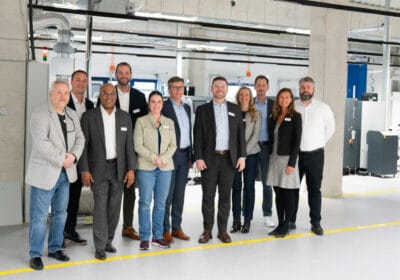In November 2020, a telecommunications company unveiled 20 new data centres across the UK as part of a £2 billion investment. As the number of new sites continues to grow, data centre operators must prepare by having the required backup power systems in place to consistently deliver service. Here, Clinton Noble, Sector Manager for Data Centre Power Solutions at energy and transportation expert Finning UK & Ireland, outlines the key considerations when designing data centre standby power.
Standby power in data centres is mission critical — continuous power prevents outages from damaging mainframes and other IT infrastructure. Having a backup supply also protects customer data that would otherwise be lost, causing financial and reputational damage.
There are several elements in a data centre’s operational power system, including the cooling system, the uninterruptible power supply (UPS) and high voltage (HV) and Low Voltage (LV) switchgear. Diesel generators are a popular choice for these backup power systems because of their reliability, fast response and long runtimes, and because they require minimal maintenance.
It’s good practice to design a genset package and standby power system in accordance with the Uptime Institute. As the internationally-recogniseddata centre authority, it determines what each site tier requires. For instance, a Tier IV site with maximum resilience must have a continuous cooling capability, unlike a tier III site. There are also other design factors that data centre operators should consider.
Size
Data centres consume large amounts of power and together make up around one per cent of the world’s total energy consumption, according to the UK Energy Research Centre. When designing a backup generator, the first, and often most important, factor is the power rating. The standby genset must have sufficient power to keep all servers and equipment online during outages.
When sizing a generator, the site’s required loads are key. Operators will need to think about start-up currents, terminal voltage, voltage and frequency variations and other factors. It’s also helpful to consider UPS efficiency, lighting and cooling loads and how these will shape the estimated requirements. There are tools available that can determine the right generator size. One example is SpecSizer, which can build a load profile and select the optimum genset.
Most data centres, including new sites, have limited floorspace. Operators can overcome this challenge by selecting a generator with a high powerdensity. This is a measure of the number of kilowatts produced in relation to size — the higher the power density, the greater the output generated in the plant room. High power density generators produce more power from smaller units and require less ancillary equipment than larger machines, reducing installation and servicing costs.
Ambient temperature
The climate and ambient temperature inside the data centre are also key. The UK is gradually getting warmer and this can impact genset performance. According to the Met Office’s 2019 State of the UK Climate report, the UK’s average temperature that year was 1.1 degrees Celsius above the levels recorded between 1961 and 1990. Site conditions, including altitude, relative humidity, and variable ambient temperature are all things that designers should consider early on.
If the ambient temperature in a data centre is not as predicted, the genset or the ancillary parts may need redesigning to accommodate the difference. If a data centre becomes too hot or cold, service issues can occur.
Because of these temperature constraints, operators don’t need to worry having a generator with a suitably rated ambient capability. However, they will need a way of removing waste heat that’s produced during power generation. Design options may include minimising the number of enclosures so that cooling air is not restricted and can flow more easily around the generator.
Maintaining uptime
Once the new genset and backup power system is installed, carrying out regular preventative maintenance is vital. If a generator fails to start, it’s often due to fuel or battery issues. If the battery’s water levels are low, this can cause damage. Fluids like oil and coolant can also become contaminated, which can lead to engine malfunction and suboptimal performance. For instance, if there’s too many metallic particles in the lube oil, this can cause excessive wear. Contamination rates vary depending on duty cycle, load factor, age and fuel type.
Data centre operators can minimise unplanned downtime by having qualified and experienced service teams on site. These specialists will regularly monitor the battery’s condition by checking the water level and voltage and cleaning and tightening the terminals. They can also check engine fluid levels, take samples of the engine’s fluids and check for contamination with detailed reports and advice issued to the operator.
Carrying out preventative action means data centre operators can spot any issues before they cause engine downtime. This makes it easier to protect sites from outages that would normally cost time and money, as well as prolong the life of their capital investment.
With one telecommunication company alone planning to open 20 data centres, reliable backup power systems will be vital in protecting new sites like these from outages. Data centre operators should think about the design of their gensets and carry out regular preventative maintenance to ensure uptime.
Need advice on designing or maintaining a diesel generator for your data centre? To find out more about Finning’s varied and experienced data centre support, visit the dedicated power solutions for data centres resource on the Finning website.







